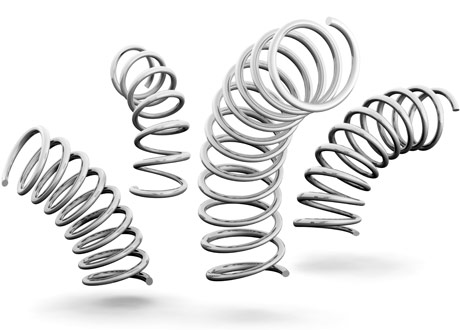Coiled Wire or Machined Springs: Making the Right Choice
Coiled Wire or Machined Springs: Making the Right Choice


Coiled wire springs.
Wire springs rank among those technological marvels whose value is immediately recognizable. We find compression, extension, or torsion springs just about everywhere, from screen doors to keyboards. Advances in materials and manufacturing technology have improved springs since they were introduced early in the Industrial Revolution, but the basic principle is the same: hot or cold spring wire is coiled to create an elastic device.
However, not all springs are coiled wire. An alternative is to use machined springs. They cost more than wire-wound springs, but where the application demands it, machined springs can offer unique capabilities. Although any machinable material including plastics can be used, metal bars are the most common starting material for machined springs. The bar is first machined into a thick wall tube form, and then a helical slot is cut revealing multiple coils. When deflected, these coils provide the desired elasticity just like a conventional coiled spring.
Cost Efficiency
However, the cost to manufacture machined springs greatly exceeds that of winding wire springs. Wire-wound springs can be created with just a few seconds of process time, whereas a machined spring requires minutes at a minimum, even using highly specialized equipment.
The cross-section of coils found on wire-wound springs is typically round. Sometimes the cross-section is rectangular or rectangular with rounded outside/inside diameter surfaces. The rectangular forms, which are less common because they cost more, provide increased stiffness and compactness of design. The orientation is usually with the long side of the rectangle radial, although it is also possible to orient the long side longitudinally. To deviate from those sizes will usually increase cost and manufacturing time.
The coils of machined springs can be made in forms that cost more in wire springs: square, rectangular, or trapezoidal. Trapezoidal coils are common to springs used in lateral bending and lateral translation. The shape allows for additional lateral motion without coil contact. Orientation of the rectangular coils can be radial or longitudinal. There are no standard sizes to the coils.
On wire-wound springs, the slots or spaces between the coils is typically uniform for torsional springs. Coils of compression springs are uniform too, but the end slots usually taper to zero. This feature is created by an additional forming process known as "closing" the ends. Extension springs can have a uniform slot width from zero to almost any size. If desired, the coils can be prestressed so that an extension spring exhibits a zero slot and the coils do not start to separate until a force threshold is reached. Typically, machined springs come with minimum slot of about 0.020 in, but generally do not exceed 0.250 in. The slot width can be closed to near zero using a stress-relieving process, but no prestressing process is currently available.
If a compression spring application requires very precise repeatability to support calibration or high-precision uses, it is best that the coils never touch. Even better, the minimum slot width needs to be wide enough to stop interference between the coils from restricting or changing the compression motion. Machined springs are ideal for calibration and precision usages from this standpoint.
Spring Sizes
The sizes of wire-wound springs range from very small delicate springs made from cold forming fine wire to very large, hot-rolled ones that originate as bar stock. Machined spring sizes are limited by machining practicality. The smallest are about 0.100 in. (2.54 mm) in diameter, and the largest are 6.0 in. (152 mm) across. Smaller or larger diameter springs will need to be shorter. Wire-wound springs can be made very long, as in a garter spring. Length is limited only by the quantity of continuous wire available on the feed spool. Machined springs, on the other hand, are limited to about 30 coils. It is very rare to see more coils than this.
In a coiled spring, the entire length of the wire contributes to elasticity because the forces and moments are distributed end to end. The spring flexure, which is the section providing the desired elasticity, is captive between the end sections. This provides structure and attachment features but contributes no elasticity. The slots on machined springs do not taper to zero at the ends. As a result, to accomplish the same elastic performance, machined springs likely need to be longer than wire ones.
The reality is that precise dimensions are easier to accomplish with machined springs than with wire springs, and precise dimensions are an important part of the foundation for precision performance. Production time is the major influence in cost, and machined springs cannot approach the low cost of the wire-wound product.
It would be very surprising to find a very simple and inexpensive machined spring produced in high quantities and costing less than $1 each. Wire-wound springs are typically made from medium and high-strength steels, nickel alloys, titanium, and stainless steels that gain their strength predominantly from heat treating and cold reduction. While stress-relieving efforts are made to reduce residuals in a wound product, the sum is not zero.
Effect of Stress
A machined spring exhibiting residual stress in the free-state will be subject to free-state deformation. One advantage of machined springs is that they can possess any feature that can be machined. This form provides balance and functionality which is essential to life.
In single start springs, wound or machined, these moments of force must be resolved at the interface between the spring and the components providing the force and deflection. Multiple start spring configurations significantly unify the lateral bending and lateral translation forces and moments around the spring's circumference given a lateral deflection.
Compression and extension stresses in both machined and wire-wound springs used in compression and extension are dominantly torsional shear. Machined springs used in compression may benefit from stress relief holes or elongated holes at the slot ends.
Much analytical work has been accomplished by spring experts and published by the Spring Manufacturers Institute, and other sources. For the most part, all this work has been accomplished to provide solutions for wire products. Since the geometries can be similar between wire and machined springs, it is not uncommon to use the same calculation sets for both. However, it should be emphasized that there is a concern among some users that closed-form solutions may not fully apply when it comes to machined springs.
[Adapted from "Which Spring to Choose: Coiled Wire vs. Machined, a Comparison," by Gary L. Boehm, Helical Products Co., for Mechanical Engineering, August 2010.]
A machined spring exhibiting residual stress in the free-state will be subject to free-state deformation.




